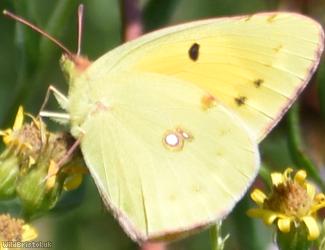Clouded Yellow - Colias croceus
Favourite Photos
Species Description
A scarce but constant and widespread breeding migrant with usually 500 individuals being recorded each year. On good years or 'Clouded Yellow years' (approximately every 10) upon thousands can be seen arriving in swarms from Southern Europe and North Africa.
Habitat includes: coasts, meadows, downland, roadside verges, railway banks, wasteland etc. Life story: Females can lay up to 600 eggs. Those arriving from the first influx breed in the UK. A few months later a second generation arrive to coincide with the hatching of the first generation's offspring with which they mate. The second arrival will remain in the UK until they die whilst the freshly hatched offspring from the first fly back down South to where their parents came from. Females that remain in the UK will also lay eggs but with little success in surviving Britain's cold, damp winters. However with winters becoming milder this is changing and in the future they may become resident.
Diet: Adults nectar on a range of flowers of which I have observed them use Red Clover, Common Knapweed and Hoary Ragwort. Food plant: Clovers (Trifolium spp.), Lucerne (Medicago sativa), Common Bird's-foot Trefoil (Lotus corniculatus). Flight period: 2 influxes a year (Late May / Early June and July to August), as the offspring of the first arrivals mingle with new immigrants. Wingspan: 57 - 62 mm.




